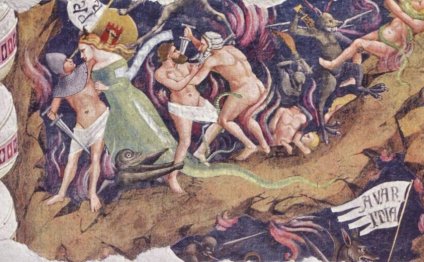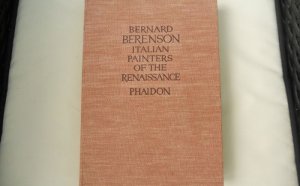
First Italian painter to paint realistic figures
This article about the development of themes in Italian Renaissance painting is an extension to the article Italian Renaissance painting, for which it provides additional pictures with commentary. The works encompassed are from Giotto in the early 14th century to Michelangelo's of the 1530s.
The themes that preoccupied painters of the Italian Renaissance were those of both subject matter and execution- what was painted and the style in which it was painted. The artist had far more freedom of both subject and style than did a Medieval painter. Certain characteristic elements of Renaissance painting evolved a great deal during the period. These include perspective, both in terms of how it was achieved and the effect to which it was applied, and realism, particularly in the depiction of humanity, either as symbolic, portrait or narrative element.
The by Piero della Francesca (above) demonstrates in a single small work many of the themes of Italian Renaissance painting, both in terms of compositional elements and subject matter. Immediately apparent is Piero's mastery of perspective and light. The architectural elements, including the tiled floor which becomes more complex around the central action, combine to create two spaces. The inner space is lit by an unseen light source to which Jesus looks. Its exact location can be pinpointed mathematically by an analysis of the diffusion and the angle of the shadows on the coffered ceiling. The three figures who are standing outside are lit from a different angle, from both daylight and light reflected from the pavement and buildings.
The religious theme is tied to the present. The ruler is a portrait of the visiting Emperor of Byzantium.Flagellation is also called "scourging". The term "scourge" was applied to the plague. Outside stand three men representing those who buried the body of Christ. The two older, Nicodemus and Joseph of Arimathaea, are believed to be portraits of men who recently lost their sons, one of them to plague. The third man is the young disciple John, and is perhaps a portrait of one of the sons, or else represents both of them in a single idealised figure, coinciding with the manner in which Piero painted angels.
Elements of Renaissance painting[edit]
Renaissance painting differed from the painting of the Late Medieval period in its emphasis upon the close observation of nature, particularly with regards to human anatomy, and the application of scientific principles to the use of perspective and light.
Linear perspective[edit]
The pictures in the gallery below show the development of linear perspective in buildings and cityscapes.
- R.E. Wolf and R. Millen, Renaissance and Mannerist Art, (1968) Abrams, ISBN unknown
- Keith Chistiansen, Italian Painting, (1992) Hugh Lauter Levin/Macmillan, ISBN
- Helen Gardner, Art through the Ages, (1970) Harcourt, Brace and World,
- Michael Baxandall, Painting and Experience in Fifteenth Century Italy, (1974) Oxford University Press,
- Luciano Berti, Florence: the city and its art, (1971) Scala, ISBN unknown
- Luciano Berti, The Ufizzi, (1971) Scala, Florence. ISBN unknown
- Michael Wilson, The National Gallery, London, (1977) Scala, ISBN 0-85097-257-4
YOU MIGHT ALSO LIKE



Share this Post
Related posts
Italian Painters of the Renaissance
Many see pictures without knowing what to look at. They are asked to admire works of pretended art and they do not know enough…
Read MoreFamous Renaissance paintings
Sometimes, when the light hits their chiseled features just the right way, it’s easy to see how certain celebrities could…
Read More





